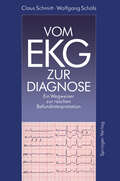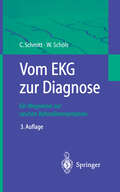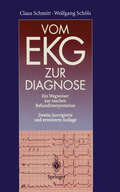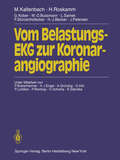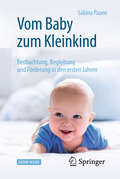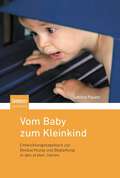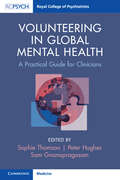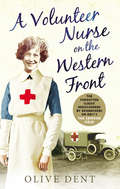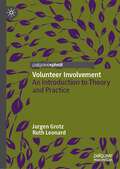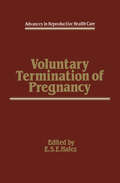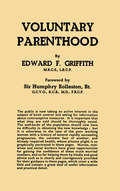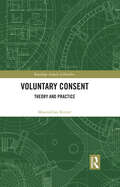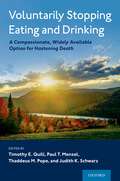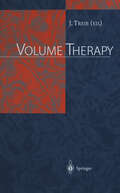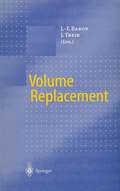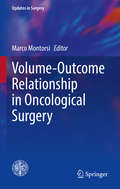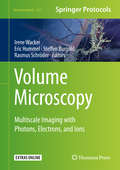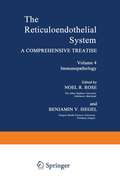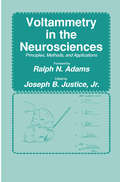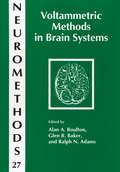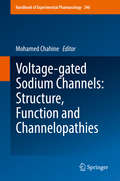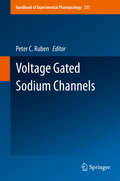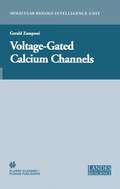- Table View
- List View
Vom EKG zur Diagnose: Ein Wegweiser zur raschen Befundinterpretation
by Claus Schmitt Wolfgang SchölsIn dieser kurzgefaßten Anleitung werden die klinisch relevanten EKG-Veränderungen übersichtlich und praxisbezogen dargestellt. Anhand plausibler "Grundregeln" wird am Beispiel vieler Original-EKG-Registrierungen exemplarisch der Weg zur richtigen elektrokardiographischen Diagnose gewiesen. Tabellarische Übersichten mit Leitliniencharakter erleichtern die Befundinterpretation. Knappe stichwortartige Texte bringen die EKG-Befunde auf den Punkt. Das Buch empfiehlt sich für alle im Not- und Nachtdienst mit akuten EKG-Befunden konfrontierten Ärzte. Es ist zudem ein hilfreicher Leitfaden für Studierende im praktischen Jahr, Ärzte im Praktikum sowie Assistenzärzte der inneren Medizin und angrenzender Fachgebiete.
Vom EKG zur Diagnose: Ein Wegweiser zur raschen Befundinterpretation
by Claus Schmitt Wolfgang SchölsKurz und übersichtlich finden Sie hier alle klinisch relevanten EKG-Veränderungen. Knappe, stichwortartige Texte bringen die EKG-Befunde auf den Punkt: hilfreich für alle, die akute EKG-Befunde interpretieren müssen.- Original-EKG-Registrierungen- praktische Leitlinien zur Befundinterpretation- zahlreiche instruktive Abbildungen"Das Buch ist somit nicht nur für Studenten und junge Ärzte zur unkonventionellen Einführung in die 'Geheimnisse` des EKG geeignet, sondern bietet auch dem Erfahrenen einen raschen Überblick über die differentialdiagnostischen Möglichkeiten bestimmter Veränderungen der EKG-Kurve." (Prof. W. Kübler, Heidelberg)
Vom EKG zur Diagnose: Ein Wegweiser zur raschen Befundinterpretation
by Claus Schmitt Wolfgang SchölsKurz und übersichtlich finden Sie hier alle klinisch relevanten EKG-Veränderungen. Knappe, stichwortartige Texte bringen die EKG-Befunde auf den Punkt: hilfreich für alle, die akute EKG-Befunde interpretieren müssen.- Original-EKG-Registrierungen- praktische Leitlinien zur Befundinterpretation- zahlreiche instruktive Abbildungen"Das Buch ist somit nicht nur für Studenten und junge Ärzte zur unkonventionellen Einführung in die 'Geheimnisse` des EKG geeignet, sondern bietet auch dem Erfahrenen einen raschen Überblick über die differentialdiagnostischen Möglichkeiten bestimmter Veränderungen der EKG-Kurve." (Prof. W. Kübler, Heidelberg)
Vom Belastungs-EKG zur Koronarangiographie
by M. Kaltenbach H. Roskamm G. Kober W.D. Bussmann L. Samek P. Stürzen-Hofecker H.-J. Becker J. PetersenVom Baby zum Kleinkind: Beobachtung, Begleitung und Förderung in den ersten Jahren
by Sabina PauenMit diesem reich bebilderter Beobachtungsleitfaden können Sie Kinder vom ersten Tag an kompetent begleiten. Lernen Sie mehr über die faszinierenden Veränderungen, die gerade zu Beginn des Lebens fast täglich stattfinden, und halten Sie fest, wann wichtige Meilensteine der Entwicklung im konkreten Fall erreicht werden. Kurze, leicht verständliche Texte und anschaulichen Illustrationen helfen dabei, den eigenen Blick für Fortschritte zu schulen. In dieser Neuauflage finden Sie nun auch Altersangaben zur Orientierung, wann einzelne Meilensteine typischerweise erreicht werden. So können Sie prüfen, ob die Entwicklung des beobachteten Kindes „normal“ verläuft. Das Buch hilft Ihnen durch modernes Fachwissen und praktische Tipps zur Frühförderung, die Entwicklung des Kindes besser zu verstehen und unterstützend zu begleiten.
Vom Baby zum Kleinkind: Entwicklungstagebuch zur Beobachtung und Begleitung in den ersten Jahren
by Sabina PauenSabina Pauen, Professorin für Entwicklungspsychologie und Biologische Psychologie an der Universität Heidelberg, hat mit Unterstützung der Jacobs-Foundation ein Beobachtungstagebuch für die ersten Lebensjahre zusammengestellt, das den liebevollen Blick auf das Kind zum Ausgangspunkt einer kompetenten Begleitung macht. Für alle relevanten Lebensbereiche werden wichtige Fortschritte des Kindes in Form von Meilensteinen beschrieben, die sich im Alltag leicht beobachten lassen und sowohl durch Bilder als auch einfach lesbare Texte anschaulich illustriert werden. Modernes Fachwissen und praktische Tipps zur Frühförderung helfen, die Entwicklung des Kindes besser zu sehen und zu verstehen. Durch die Möglichkeit, eigene Beobachtungen zu notieren, entsteht ein persönliches Tagebuch und ein nützliches Nachschlagewerk für Eltern, Tagesmütter, Erziehern und alle, die Kindern zu einem guten Start ins Leben verhelfen wollen.
Volunteering in Global Mental Health: A Practical Guide For Clinicians
by Sophie Thomson Peter Hughes Sam GnanapragasamA Volunteer Nurse on the Western Front: Memoirs from a WWI camp hospital
by Olive DentStarring Oona Chaplin as a V.A.D. (Voluntary Aid Detachment), and Suranne Jones and Hermione Norris as trained nurses, The Crimson Field is a gripping drama set in a tented hospital on the coast of France, where plucky real-life V.A.D. Olive Dent served two years of the Great War, and kept this extraordinarily vivid diary of day-to-day life – ever cheerful through the bitter cold, the chilblains, hunger and exhaustion. Resilient, courageous and resourceful, nurses, doctors and patients alike do their best to support each other. A Christmas fancy-dress ball, a concert performed by a stoic orchestra covered in bandages, church services held in a marquee and letters from Blighty all keep spirits up in camp, as wounded soldiers suffer terribly with quiet dignity on the makeshift wards, and nurses rush round tirelessly to make them as comfortable as possible.With original illustrations throughout by fellow V.A.D.s, Olive’s memoir is a fascinating period piece, a rare first-hand account of this little-known story, which will resonate very strongly with viewers of The Crimson Field.
Volunteer Involvement: An Introduction to Theory and Practice
by Jurgen Grotz Ruth LeonardThis book provides a comprehensive overview of the latest theory and practice for volunteer involvement. It represents a milestone for knowledge of how and why volunteers become involved and will be essential reading for practitioners, policy makers and funders. Offering exercises and examples from practice, it introduces concepts for understanding volunteers’ agency and for critically assessing ways in which those who seek to involve volunteers can respond to rapidly changing environments. The authors draw on a combination of theoretical perspectives and practical experiences to develop approaches based on individuals and community strengths and assets, underlining the need for conviviality, respect and enjoyment in volunteer involvement.
Voluntary Parenthood
by Edward F. GriffithVoluntary Parenthood discusses scientific research relating the significance of contraception to ordinary life of the population, specifically to the so-called voluntary parenthood. This seven-chapter text considers the influence of reasonable family planning in marriage.The opening chapter provides an overview of the problems connected with marriage and contraception. The subsequent chapters deal with the different methods of family limitation, the mechanical methods of controlled contraception, and the issues related to abortion. These topics are followed by discussions of the role of sex in marriage and the biological aspects of sex. The closing chapter provides medical case histories concerning various conditions in which pregnancy is contra-indicated.This book is of value to nurses, midwives, social workers, and the general public.
Voluntary Consent: Theory and Practice (Routledge Annals of Bioethics)
by Maximilian KienerVoluntariness is a necessary condition of valid consent. But determining whether a person consented voluntarily can be difficult, especially when people are subjected to coercion or manipulation, placed in a situation with no acceptable alternative other than to consent to something, or find themselves in an abusive relationship. This book presents a novel view on the voluntariness of consent, especially medical consent, which the author calls Interpersonal Consenter-Consentee Justification (ICCJ). According to this view, consent is voluntary if and only if the process by which it has been obtained aligns with specific principles of interpersonal justification. ICCJ is distinctive because it explains voluntary consent neither as a ‘psychological’ concept indicative of the inner states of a person’s mind (e.g. willingness or reluctance) nor as a ‘circumstantial’ concept indicative of a person’s set of options. Rather, ICCJ explains the voluntariness of consent as an ‘interpersonal’ concept requiring the absence of illegitimate control within the interaction between the person giving consent and the person receiving it. In so doing, ICCJ further develops the notion of interpersonal justification, known from contractualist theories in moral philosophy, and introduces it to the debate on consent. The author employs a top-down approach, defending ICCJ’s key characteristics on the basis of general theoretical arguments, as well as a bottom-up approach, supporting ICCJ in its application to clinical challenges such as nudging and manipulation, living organ donation, and clinical trials. Voluntary Consent will appeal to researchers and advanced students in normative ethics, bioethics, philosophy of law, behavioural psychology, and medicine.
Voluntary Consent: Theory and Practice (Routledge Annals of Bioethics)
by Maximilian KienerVoluntariness is a necessary condition of valid consent. But determining whether a person consented voluntarily can be difficult, especially when people are subjected to coercion or manipulation, placed in a situation with no acceptable alternative other than to consent to something, or find themselves in an abusive relationship. This book presents a novel view on the voluntariness of consent, especially medical consent, which the author calls Interpersonal Consenter-Consentee Justification (ICCJ). According to this view, consent is voluntary if and only if the process by which it has been obtained aligns with specific principles of interpersonal justification. ICCJ is distinctive because it explains voluntary consent neither as a ‘psychological’ concept indicative of the inner states of a person’s mind (e.g. willingness or reluctance) nor as a ‘circumstantial’ concept indicative of a person’s set of options. Rather, ICCJ explains the voluntariness of consent as an ‘interpersonal’ concept requiring the absence of illegitimate control within the interaction between the person giving consent and the person receiving it. In so doing, ICCJ further develops the notion of interpersonal justification, known from contractualist theories in moral philosophy, and introduces it to the debate on consent. The author employs a top-down approach, defending ICCJ’s key characteristics on the basis of general theoretical arguments, as well as a bottom-up approach, supporting ICCJ in its application to clinical challenges such as nudging and manipulation, living organ donation, and clinical trials. Voluntary Consent will appeal to researchers and advanced students in normative ethics, bioethics, philosophy of law, behavioural psychology, and medicine.
Voluntarily Stopping Eating and Drinking: A Compassionate, Widely-Available Option for Hastening Death
by Timothy E. Quill, MD, Paul T. Menzel, PHD, Thaddeus M. Pope, JD, PHD and Judith K. Schwarz, PHD, RNIn the 21st century, people in the developed world are living longer. They hope they will have a healthy longer life and then die relatively quickly and peacefully. But frequently that does not happen. While people are living healthy a little longer, they tend to live sick for a lot longer. And at the end of being sick before dying, they and their families are frequently faced with daunting decisions about whether to continue life prolonging medical treatments or whether to find meaningful and forthright ways to die more easily and quickly. In this context, some people are searching for more and better options to hasten death. They may be experiencing unacceptable suffering in the present or may fear it in the near future. But they do not know the full range of options legally available to them. Voluntary stopping eating and drinking (VSED), though relatively unknown and poorly understood, is a widely available option for hastening death. VSED is legally permitted in places where medical assistance in dying (MAID) is not. And unlike U.S. jurisdictions where MAID is legally permitted, VSED is not limited to terminal illness or to those with current decision-making capacity. VSED is a compassionate option that respects patient choice. Despite its strongly misleading image of starvation, death by VSED is typically peaceful and meaningful when accompanied by adequate clinician and/or caregiver support. Moreover, the practice is not limited to avoiding unbearable suffering, but may also be used by those who are determined to avoid living with unacceptable deterioration such as severe dementia. But VSED is "not for everyone." This volume provides a realistic, appropriately critical, yet supportive assessment of the practice. Eight illustrative, previously unpublished real cases are included, receiving pragmatic analysis in each chapter. The volume's integrated, multi-professional, multi-disciplinary character makes it useful for a wide range of readers: patients considering present or future end-of-life options and their families, clinicians of all kinds, ethicists, lawyers, and institutional administrators. Appendices include recommended elements of an advance directive for stopping eating and drinking in one's future if and when decision making capacity is lost, and what to record as cause of death on the death certificates of those who hasten death by VSED.
Voluntarily Stopping Eating and Drinking: A Compassionate, Widely-Available Option for Hastening Death
In the 21st century, people in the developed world are living longer. They hope they will have a healthy longer life and then die relatively quickly and peacefully. But frequently that does not happen. While people are living healthy a little longer, they tend to live sick for a lot longer. And at the end of being sick before dying, they and their families are frequently faced with daunting decisions about whether to continue life prolonging medical treatments or whether to find meaningful and forthright ways to die more easily and quickly. In this context, some people are searching for more and better options to hasten death. They may be experiencing unacceptable suffering in the present or may fear it in the near future. But they do not know the full range of options legally available to them. Voluntary stopping eating and drinking (VSED), though relatively unknown and poorly understood, is a widely available option for hastening death. VSED is legally permitted in places where medical assistance in dying (MAID) is not. And unlike U.S. jurisdictions where MAID is legally permitted, VSED is not limited to terminal illness or to those with current decision-making capacity. VSED is a compassionate option that respects patient choice. Despite its strongly misleading image of starvation, death by VSED is typically peaceful and meaningful when accompanied by adequate clinician and/or caregiver support. Moreover, the practice is not limited to avoiding unbearable suffering, but may also be used by those who are determined to avoid living with unacceptable deterioration such as severe dementia. But VSED is "not for everyone." This volume provides a realistic, appropriately critical, yet supportive assessment of the practice. Eight illustrative, previously unpublished real cases are included, receiving pragmatic analysis in each chapter. The volume's integrated, multi-professional, multi-disciplinary character makes it useful for a wide range of readers: patients considering present or future end-of-life options and their families, clinicians of all kinds, ethicists, lawyers, and institutional administrators. Appendices include recommended elements of an advance directive for stopping eating and drinking in one's future if and when decision making capacity is lost, and what to record as cause of death on the death certificates of those who hasten death by VSED.
Volume Therapy
by J. Boldt D. J. Cole F. Cortbus M. T. Grauer A Haass Heinrich Iro E. T. Riley K. W. Ruprecht R. Schell V. Scherer W. I. Steudel G. Stier F. WaldfahrerVolume therapy or infusion therapy is used worldwide for the treatment of hypovolemia caused by surgical blood and plasma losses, trauma, burns, or infections. Interestingly, significant differences exist between countries regarding the use of plasma substitutes. In the United States, crystalloids and albumin are more popular, whereas in Europe artificial colloids such as hydroxyethyl starch are preferred. From an international perspective, it is notable that volume therapy using hydroxyethyl starch is an established therapy for the treatment of cerebral, retinal, otogenic, and peripheral circulation disorders in Germany. In other countries, crys talloids are mostly used to treat dehydration or hypovolemia, for example in brain stroke. In recent years, new data made it possible to overcome national differences and agree on an evidence-based, international con sensus. The efficacy of different plasma substitutes for a volume therapy last ing several days has not been sufficiently studied in the past. Long-term volume therapy of patients with cerebral perfusion disorders is an excel lent model for studying the effects of artificial colloids in detail, because of the high doses of colloids that are administered. Through a compari son of commonly used plasma substitutes, we were able to show that sig nificant differences exist between different colloids, for example in their effect on coagulation. After repeated infusion, hydroxyethyl starches that are difficult to degrade lead to an accumulation of large molecules that are difficult to eliminate. These large molecules impair factor VIII/von Willebrand factor.
Volume Replacement
by Jean-Francois Baron and Johannes TreibBecause of their therapeutic safety, hydroxyethylstarch, gelatin and dextrans are among the most frequently used drugs in the world. Recent studies have shown that bleeding disorders, anaphylactic reactions and storage in the body depend decisively on the nature of the administered plasma substitute. Through interdisciplinary cooperation the "First European Volume Replacement Conference" has established indications for the use of individual plasma substitutes to improve the efficacy and therapeutic safety of volume replacement therapy.
Volume-Outcome Relationship in Oncological Surgery (Updates in Surgery)
by Marco MontorsiThe book offers a comprehensive review of the relations between volumes and outcomes in oncological surgery especially in Italian hospitals, based on national and regional data. After illustrating the quality-control methodology and the determinants of surgical outcomes, it discusses the volume-outcome relationship in different fields of surgical oncology (cancers of the upper and lower gastrointestinal tract, hepatopancreatobiliary system, breast, sarcomas etc.) and suggests possible solutions. The latest findings from Europe and the USA are also presented.
Volume Microscopy: Multiscale Imaging with Photons, Electrons, and Ions (Neuromethods #155)
by Irene Wacker Eric Hummel Steffen Burgold Rasmus SchröderThis volume discusses different approaches to workflows for large volume electron microscopy - from preparation of samples to their imaging in a variety of microscopes - in some cases also applying correlative techniques. The chapters in this book cover topics such as correlative super resolution and electron microscopy to detect molecules in their native cellular context; low-threshold access to serial section arrays; improving serial blockface SEM by focal charge compensation; FIBSEM analysis of interfaces between hard technical devices and soft neuronal tissue; and image processing for volume electron microscopy. In Neuromethods series style, chapters include the kind of detail and key advice from the specialists needed to get successful results in your laboratory.Cutting-edge and authoritative, Volume Microscopy: Multiscale Imaging with Photons, Electrons, and Ions is a valuable resource for novice and expert scientists interested in learning more about this evolving field.
Volume 4 Immunopathology
by Noel RoseThis comprehensive treatise on the reticuloendothelial system is a project jointly shared by individual members of the Reticuloendothelial (RE) Society and bio medical scientists in general who are interested in the intricate system of cells and molecular moieties derived from these cells which constitute the RES. It may now be more fashionable in some quarters to consider these cells as part of what is called the mononuclear phagocytic system or the lymphoreticular system. Nevertheless, because of historical developments and current interest in the subject by investigators from many diverse areas, it seems advantageous to present in one comprehensive treatise current information and knowledge con cerning basic aspects of the RES, such as morphology, biochemistry, phylogeny and ontogeny, physiology, and pharmacology as well as clinical areas including immunopathology, cancer, infectious diseases, allergy, and hypersensitivity. It is anticipated that by presenting information concerning these apparently heterogeneous topics under the unifying umbrella of the RES attention will be focused on the similarities as well as interactions among the cell types constitut ing the RES from the viewpoint of various disciplines. The treatise editors and their editorial board, consisting predominantly of the editors of individual vol umes, are extremely grateful for the enthusiastic cooperation and enormous task undertaken by members of the biomedical community in general and especially by members of the American as well as European and Japanese Reticuloendothe lial Societies.
Voltammetry in the Neurosciences: Principles, Methods, and Applications (Contemporary Neuroscience)
by Jr. JusticeEven before the time of organized scientific investigation, hu mans had begun pondering and attempting to explain the work ing of the brain and the mental and behavioral states it produces. In the last twenty years there has been an almost explosive in crease in brain research. Beginning perhaps with the pioneering efforts of Francis O. Schmitt to establish the Neuroscience Re search Program and the later development of the Society for Neuroscience, there has emerged a large and powerful multi disciplinary research force devoted to understanding even the ru dimentary aspects of brain functioning. Chemists, physicists, and engineers with their special expert ise in quantitative physical measurements have teamed up with the neurobiologists, who best know the texture and design of brains, to produce particularly effective new approaches. No where is this more evident than in the recently developed meth ods like positron emission tomography and magnetic resonance imaging-techniques that allow one to observe on-going brain ac tivity in humans. This volume concerns a considerably more modest approach: the use of microelectrodes to electrochemically monitor certain aspects of chemical dynamics in functioning ani mal brain systems. The method provides signals that can be di rectly related to chemical neurotransmission. It is a relatively new technique, the first practical measurements having been made in the 1970s, and it is continuously undergoing refinement. The organizer of this book, Jay Justice, is eminently qualified for the task.
Voltammetric Methods in Brain Systems (Neuromethods #27)
by Alan A. Boulton, Glen B. Baker and Ralph N. AdamsVoltage-gated Sodium Channels: Structure, Function and Channelopathies (Handbook of Experimental Pharmacology #246)
by Mohamed ChahineThis book provides a timely state-of-the-art overview of voltage-gated sodium channels, their structure-function, their pharmacology and related diseases. Among the topics discussed are the structural basis of Na+ channel function, methodological advances in the study of Na+ channels, their pathophysiology and drugs and toxins interactions with these channels and their associated channelopathies.
Voltage Gated Sodium Channels (Handbook of Experimental Pharmacology #221)
by Peter C. RubenA number of techniques to study ion channels have been developed since the electrical basis of excitability was first discovered. Ion channel biophysicists have at their disposal a rich and ever-growing array of instruments and reagents to explore the biophysical and structural basis of sodium channel behavior. Armed with these tools, researchers have made increasingly dramatic discoveries about sodium channels, culminating most recently in crystal structures of voltage-gated sodium channels from bacteria. These structures, along with those from other channels, give unprecedented insight into the structural basis of sodium channel function. This volume of the Handbook of Experimental Pharmacology will explore sodium channels from the perspectives of their biophysical behavior, their structure, the drugs and toxins with which they are known to interact, acquired and inherited diseases that affect sodium channels and the techniques with which their biophysical and structural properties are studied.
Voltage-Gated Calcium Channels (Molecular Biology Intelligence Unit)
by Gerald Werner Zamponioltage-gated calcium channels are essential mediators of a range of physiological functions, including the communication between nerve Vcells, the regulation of heart beat, muscle contraction, and secretion of hormones such as insulin. Consequently, these channels are critical phar macological targets in the treatment of a variety of disorders, such as epi lepsy, hypertension, and pain. Voltage-gated calcium channels have there fore been subject to intense study by numerous investigators over the past few decades, and an immense body of work has accumulated. In this book, we provide the first comprehensive overview of our current state of knowl edge concerning this exciting field of research. Leading off with a general review of calcium signaling and techniques to measure calcium channel ac tivity, the book delves into a provocative overview of the history of the cal cium channel field, contributed by one of the key pioneers in the field. Dr. Richard Tsien. This is followed by an in depth review of the biochemical and molecular biological characterization of calcium channel genes by Drs. Catterall and Snutch whose research has resulted in major advances in the calcium channel field. A number of chapters are dedicated towards various aspects of calcium channel structure and function, including channel gat ing, permeation, modulation and interactions with members of the exo- totic machinery—contributed by both established leaders and rising stars in the field.
